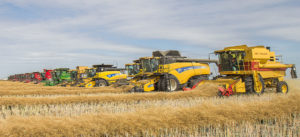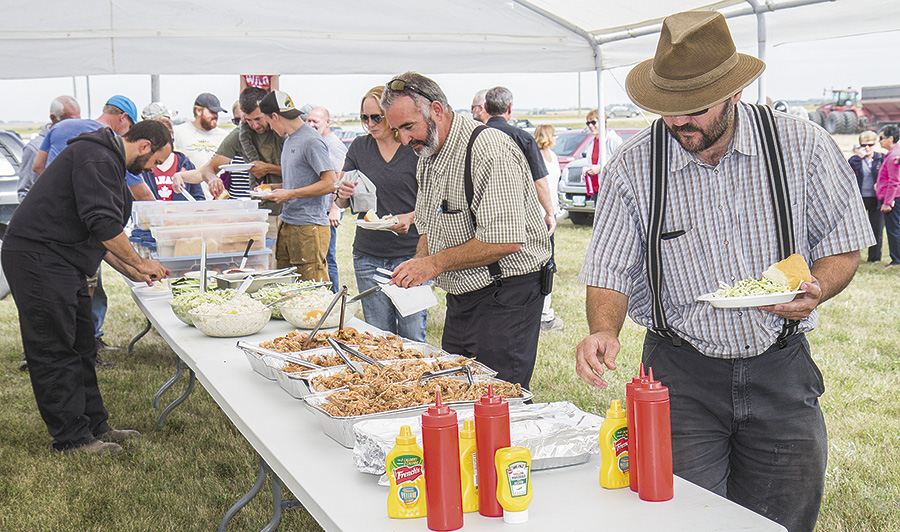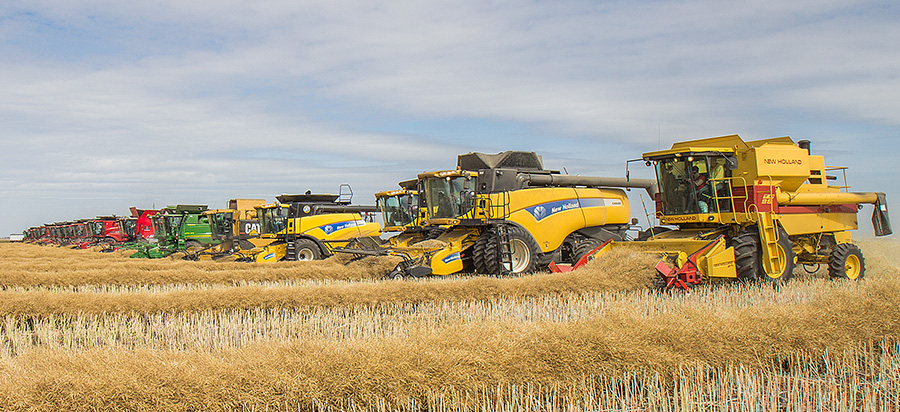
BY KIM LANGEN
Long tables, loaded with fresh and delicious food, will be laid out just before noon today in a golden field, to celebrate bringing in a very special crop of wheat.
And after the free lunch, the field of wheat, planted this spring next to Hwy 3 (on the north side, between Cartwright and the Hwy 18 intersection), is to be simultaneously combined by some 25 to 30 operators working in tandem.
“Whoever would like to come for the lunch, please do come, and help us celebrate this wonderful day,” said local farmer Betty Turner, who often takes the driving seat in one of the massive machines. “It’s our tenth anniversary of cropping for the Canadian Foodgrains Bank, and we are very excited.”
The Killarney Growing Project volunteers, which include Turner, still have around 30 of the 160 acres of crop left to ‘sell’, she said.
“People can buy one for $250, which covers the cost of inputs,” she said. “We will put them on the map.”
The group is also accepting silent auction donation bids for a beautiful framed photo of last year’s harvest day. The photo will be on display at the Lunch in the Field event.
Speeches begin at 11:45 a.m., followed by lunch (drivers eat first), and combining gets underway at 1 p.m. Don’t miss the impressive show.
For more information on the international aid charity, go to the Canadian Foodgrains Bank website.
Proceeds from the local harvested crop – along with multiple matching government donations – will go directly to the Canadian charity to help feed, educate, and improve conditions for people living in countries in need around the world.
See this Friday’s Killarney Guide for more on the big event.
A look back at the 2017 harvest
 TAKIN’ CARE OF BUSINESS – An incredible line of 26 combines stretched across the Killarney Growing Project’s 160-acre canola field west of town on Wednesday afternoon. More than 300 people attended the charity harvest event, which raises thousands of dollars for the Canadian Foodgrains Bank.
TAKIN’ CARE OF BUSINESS – An incredible line of 26 combines stretched across the Killarney Growing Project’s 160-acre canola field west of town on Wednesday afternoon. More than 300 people attended the charity harvest event, which raises thousands of dollars for the Canadian Foodgrains Bank.
Larry Cox/Photo
A record 26 combines, plus grain carts, semi trucks, and trailers assemble for Killarney Growing Project harvest
BY KIM LANGEN
It was an epic vista last Wednesday afternoon, as 26 rumbling combines spread out across a field of swathed canola west of town.
The volunteer drivers – most carrying a passenger on board to witness the occasion – waited for a radio signal from the field operations manager, Myron Peters, for the cue to harness their horsepower, and proceed.
It was a historic event for the Killarney Growing Project.
“We have broken all records,” said Peters. “We have 26 combines, and I’m sure there are over 300-plus people out there. One of our drivers, Brian Burton, has spent two hours driving in his combine just to be part of this harvest today.”
Operators were each supplied with a radio, cautioned on their auger length, and warned to watch for the massive grain carts.
“Put your hand-held radios on Channel 1, and crack that radio as loud as it can go,” Peters told the drivers.
Overhead, a drone camera operated by Matt Reimer recorded the movement and grace of the combines, as they moved forward through the swaths of oilseed, crossing the Mayfair Colony land towards a massive line of waiting onlookers.
Last year, Brian Archibald created a stunning video of the Killarney Growing Project’s Canadian Foodgrains Bank Harvest in Killarney, at Dennis and Betty Turner’s land, and unleashed it online.
“That video had 1.1 million views,” said Peters. “It was incredible.”
This year the Killarney Growing Project decided to open their Lunch in the Field segment of the harvest to all comers: both to get their message out, and to offer a wonderful experience of agricultural life on the Prairies.
And new this year was a chance to taste the food of Ethiopia, one of the countries supported by the Canadian Foodgrains Bank.
Twin sisters Fikira and Tizita Galbraith, who were born in Ethiopia, but grew up on a mixed farm north of Brandon, offered diners a taste of ethnic food from their homeland.
“These are rolls of injera, which you use to scoop up the beef tibs or the yemisir wat, using just your right hand,” they told the interested diners.
Injera is a highly fermented sourdough flatbread, made with flour from ground teff seed. It was light and bubbly, and very tangy and stretchy.
The beef tibs were spicy, tender, small cubes of spiced meat.
Yemisir wat was a dish of red lentils cooked with wat – a sauce made with onion, garlic and Ethiopian spices – and was richly aromatic and delicious.
Squares of honey bread were also on offer, with a mild and slightly sweet flavour that complemented the mild heat of the meat and lentil dishes.
“We didn’t cook this food ourselves,” admitted Fikira Galbraith. “The injera is very hard to make, although we have tried. There’s a restaurant in Brandon; it’s called ‘Tana,’ and it’s run by a wonderful couple who make authentic Ethiopian food. They prepared it, and gave us extra with our order so that everyone could have a taste today.”
Next to the twins was a series of long tables, filled with lunch and dessert prepared by the Willow Creek and Holmfield Hutterite Colony kitchens.
Pulled pork, from a slow-roasted barbequed hog attended through the night hours at Willow Creek, plus delicate white rolls, a delicious potato salad, tiny pickled cucumbers, fresh carrots and celery, and a cabbage salad filled the buffet.
Holmfield Colony provided the sweet end of the tables, with pumpkin spice squares and enormous double chocolate mint cookies.
Tim Hofer of Willow Creek Colony said he thought the CFGB harvest created its own special energy.
“It’s the cause, and the togetherness,” he said. “ We are all from different walks of life, and we have so much to be grateful for.”
Combine driver and Killarney Growing Project member Betty Turner said every part of Wednesday’s event was a success.
Just 100 of the 160 acres of L 252 Invigor canola had been ‘sold’ to donors for $250 (cost of inputs) at the beginning of the day, she said.
But that changed by the minute.
“By the end, we only had 13 acres left,” she said. “I hope we can still sell them, and we would take more. There were lots of donations in the pail during the lunch too. The canola yielded 60.8 bushels per acre, which was above average. It was a super crop, and it was amazing for that field.”
Harold Penner, regional resource coordinator with the CFGB, said that help was always needed somewhere in the world, especially Haita and Burma this year.
And every acre in Canada counted.
“Thanks to all of you who have come to participate in this meaningful event,” he said. “We do our little part, with our little acres here, and it’s all part of our fundraising for the Canadian Foodgrains Bank.”
The local growing group is looking for a quarter section for next year’s project, so if you have the land to rent them, let them know.
And if you still wish to donate to the Killarney Growing Project, for the Canadian Foodgrains Bank – and maybe buy one of the remaining acres – contact Turner at 204-523-8852.
 A TASTE OF ETHIOPIA – Local twin sisters Tizita (left) and Fikira Galbraith, who were born in Ethiopia, made a special delivery of some fragrant Ethiopian dishes during the Lunch in the Field. Diners got to sample authentic injera, beef tibs, yemisir wat, and honey bread.
A TASTE OF ETHIOPIA – Local twin sisters Tizita (left) and Fikira Galbraith, who were born in Ethiopia, made a special delivery of some fragrant Ethiopian dishes during the Lunch in the Field. Diners got to sample authentic injera, beef tibs, yemisir wat, and honey bread.
 DRIVERS FIRST – Combine operators were first up at the long and laden buffet during the Lunch in the Field. Willow Creek Colony provided trays of delicious pulled barbequed pork (pictured), along with salads and fresh rolls, while Holmfield Colony baked the desserts.
DRIVERS FIRST – Combine operators were first up at the long and laden buffet during the Lunch in the Field. Willow Creek Colony provided trays of delicious pulled barbequed pork (pictured), along with salads and fresh rolls, while Holmfield Colony baked the desserts.
 HEADERS TO THE FORE – Volunteer drivers, operating a whopping 26 combines, are pictured here with their headers taking up the crop, during the Killarney Growing Project’s harvest on Wednesday. The row of machines is so long you can hardly see the end of the line. One combine operator drove for two hours just to attend the event.
HEADERS TO THE FORE – Volunteer drivers, operating a whopping 26 combines, are pictured here with their headers taking up the crop, during the Killarney Growing Project’s harvest on Wednesday. The row of machines is so long you can hardly see the end of the line. One combine operator drove for two hours just to attend the event.


 Kim Langen/Killarney Guide Photos
Kim Langen/Killarney Guide Photos